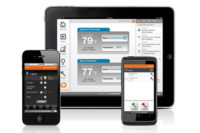
|
|
Home area networks continue to expand separately and while converging. Intelligent and communicating home appliances are just more devices on the net. Photo Courtesy of Bosch Home Appliances |
Inside and around homes, in homeowner vehicles and through diverse mobile devices, everything, if not everyone, is starting to talk among themselves.
Yet, as more technology goes home bound, the current and future of home area networks (HAN) remain up in the air. What really works today and for what types of applications? How do various approaches work together, since, in the short term, coexistence among various and sometimes competing technologies and applications is a given? What will be workable, scalable and cost effective in the long term?
Most important to electronic system contractors (ESC), what are the best business models specific to HANs in terms of client relationships, revenue, margins, recurring income and the future profile of their businesses?
For homeowner clients, there are many choices and much confusion when it comes to the HAN platform, especially in customized and more complex designs.
A bad thing, huh? Well, according to ESCs and tech experts, look at it differently. Lots of choices means value — that is, revenue — for expert, customized advice, installation, service and maintenance. Confusion means there is an opportunity to educate clients, potentially to “right sell” or even upsell now or later, with a better chance of a longer relationship.
Cha-ching.
Still, it depends on how high a firm wants to go beyond the traditional.
“Be the IT manager for the home,” says Michael Rogers, the “Practical Futurist,” technology pioneer, novelist and journalist as well as futurist-in-residence for The New York Times and columnist for MSNBC. A recent presentation by him impressed the executives at Vector Security, headquartered in Pittsburgh.
Of course, traditional home security and expanded services from firms such as ADT Pulse can be viewed as a kind of home area network connected to a wide area network through a homeowner’s mobile devices and third-party monitoring.
“Home security systems are moving decisively to IP. But who will be the keeper of the home network? Telecoms and cable companies?” questions Rogers, who suggests that ESCs can replicate the pioneering business model of British Telecom. “They put in routers and set-top boxes and started getting calls for additional help and services. Instead of turning away business, they embraced it and became the IT manager for the home.”
While Rogers contends that cable and telecoms may be able to mass market the bundle beyond the triple play of telephone, television and Internet to add home networking, the closer relationship, ability to customize and more appreciated responsiveness of ESCs may make a big difference, especially with savvy, early adopter and higher income clients.
There are many technologies, approaches, standards, protocols, devices, systems and obstacles involved in home area networks. To read more about existing and emerging approaches, click here.
No doubt, there are many challenges. Peter Goldring, chief executive officer (CEO) at Sentry Protection of Lake Success, N.Y., feels some of the activity specific to home area network is “without real direction” at this time.
So when it comes to HANs that go way beyond do it yourself (D.I.Y.), it is important for the platform to be scalable, according to Craig Metzger of GuardMe Security of Old Bridge N.J., who points out that devices, locations and needs are always changing. For example, it is anticipated that home energy management will have a crucial influence on the development of HANs.
Others believe that there will be at least another HAN in addition to home energy and its natural connection to traditional home automation nets. According to a white paper by Nathan Ota of Trilliant, a smart grid communications company in Redwood City, Calif., “It’s important to note that the term ‘home area network’ is also used with home-based multimedia applications that integrate voice, video and data communications to support media centers for viewing television and movies, voice over IP (VoIP), broadband Internet access and other forms of entertainment. It is possible there may be some convergence between the two different HANs someday, but they are expected to coexist as separate networks for the foreseeable future.”
Still, who recommends, installs, monitors and at times controls to some degree the HAN for the homeowner should be in the proverbial cat-bird seat. Gordon van Zuiden, president of cyberManor of Los Gatos, Calif., and a member of CEDIA’s board of directors, sees valuable convergence happening now. “Everything we have now has a networking aspect.”
Ken Erdmann of Erdmann Electric of Springville, Utah, and immediate past president of CEDIA, agrees with van Zuiden. Still, he says, there remains an alphabet soup of wired and wireless means to network. “It is often a matter of the new and shiny and they may link. But how do you integrate it all? Some things do not play well together. Ethernet is a commonality. ZigBee is in the network but communications to the system is over Ethernet.”
Erdmann also sees a measureable benefit for ESCs as compared to cable, telecom and big retailers diving into the mass market of home area networks. Those folks “are not particularly customer friendly. They plateaued with their current offerings.” On the other hand, “we deal more with the technology and know the customer better.” In addition, “They are spending a lot of money on advertising” making a case for getting people excited about HANs, home entertainment, energy management and automation. But it may take the CEDIA-level residential customer to see the value in these systems designed, installed and sometimes now managed by ESCs.
Goldring adds that firms working home systems integration and HANs need both the technological competency to handle such assignments as well as an understanding of solutions that saves their clients’ money. While he believes ZigBee and Z-Wave are “solid players,” and powerline has its applications, “the cable and telecoms are missing the boat a bit. The set-top box should go back to a central station” to enlarge that application to cover more home systems.
But, beyond a kind of Best Buy Geek Squad business model when it comes to HANs, how else do ESCs make additional revenue on HANs?
Caleb Yaryan, chief technology officer at Certified Cyber Solutions (CCS) of Charleston, S.C., has one answer with residential network security, a monitoring solution that addresses cyber security, remote access accountability and long-term analytical and diagnostics capabilities through the RSC or home dealer or integrator. Technology from CCS uses a blade server at the homeowner location that monitors devices connected to the home’s network and can send alerts or other diagnostic information to the integrator so that a third party can properly manage his or her client’s home technology. Obviously, there is more emphasis on security of the HAN and the devices that hang from it.
“Probably the most critical elements in any network monitoring solution are the devices located at the client’s home,” says Yaryan. Integrators can now set up service plans for virtually any client, from apartments, vacation home, all the way up to larger estates.

